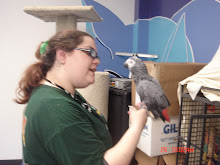
I just spent the past couple of days doing a deep clean of the cages and a major rearranging of perches and toys.
This is one of my favorite things to do as it allows me to be creative with enriching my birds.
Each of my birds have very specific likes and dislikes. Some of it is health related, some based on natural wild behavior and other just the personal preference of the bird.
Marnie is an African Grey and loves to go down to the bottom of the cage to chicken scratch just like the wild CAGs. Because of this I like to give her extra layers of newspaper, so she can shred it up scratching, and get through to the tray.
She also does not really care for chewing on wood; She prefers to take care of her beak on her perches. Therefore I do not give her much in the way of wooden toys.
Her favorite toys a bright acrylic ones, which she loves to beat the snot out of.
Lucha on the other hand LOVES to shred up wood. I normally give him at least two or three different wooden toys, of different colours and woods, in various spots around his cage. Lucha could not care less about acrylic toys, unless they are for foraging.
Puff loves to shred! Nothing seems to make him happier than hanging out on the bottom of his cage and turning cardboard into confetti. I save all my cardboard from groceries and shipping and toss it in his cage.
On top of their usual toys, I also include lots of foraging toys of different types. I have a number of them which are made of tough plastic or acrylic. All the birds love getting their pellets out of these, and I rotate them between cages to change up the methods they have to use to get to their foods.
I also like to make foraging toys out of destructible materials like coffee filters.
Over the years I have put together a large selection of various perches. I have multiple thicknesses, lengths and kinds of weed, along with perches made of acrylic, rope, boings, flat perches and concrete. When doing a change up I like to not only change the type of perches, but also the locations.
The combination of changing up toys and perches gives my birds the opportunity to use their brains to adapt to their new cage environment.



























